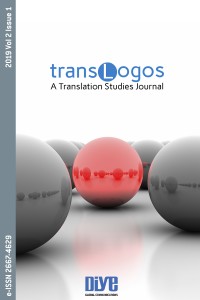Öz
Kaynakça
- Dirckx, John H. 1976. The Language of Medicine: Its Evolution, Structure and Dynamics. Maryland: Harper and Row.
- EMT Expert Group. 2009. “Competences for Professional Translators, Experts in Multilingual and Multimedia Communication.” European Commission. https://ec.europa.eu/info/sites/info/files/emt_competences_translators_en.pdf.
- Filatova, Svetlana. 2017. “Becoming a Medical Translator: Who Are the Experts?” Master's thesis, Istanbul 29 Mayıs University.
- Fraser, Janet. 2000. “The Broader View: How Freelance Translators Define Translation Competence.” In Developing Translation Competence, edited by Christina Schäffner and Adab Beverly, 51-62. Amsterdam: John Benjamins.
- Hathiram, Bachi T., and Vicky S. Khattar. 2013. Facial Plastics, Cosmetics and Reconstructive Surgery. Vol. 3 of Atlas of Operative Otorhinolaryngology and Head and Neck Surgery. New Delhi: Jaypee Brothers.
- ISO (International Organization for Standardization). 2015. Translation Services — Requirements for Translation Services. ISO 17100. http://www.eurocom.at:8080/vmapplicants/docs/Excerpt%20from%20ISO_17100_2015.pdf.
- Neubert, Albrecht. 2000. “Competence in Language, in Languages, and in Translation.” In Developing Translation Competence, edited by Christina Schäffner and Beverly Adab, 3-18. Amsterdam: John Benjamins.
- PACTE. 2003. “Building a Translation Competence Model.” In Triangulating Translation: Perspectives in Process Oriented Research, edited by Fabio Alves, 43-66. Amsterdam: John Benjamins.
- Presas, Marisa. 2000. “Bilingual Competence and Translation Competence.” In Developing Translation Competence, edited by Christina Schäffner and Beverly Adab, 19-31. Amsterdam: John Benjamins.
- Pym, Anthony. 2003. “Redefining Translation Competence in an Electronic Age: In Defence of a Minimalist Approach.” Meta 48 (4): 481-497. doi: 10.7202/008533ar.
- Toury, Gideon. 1995. Descriptive Translation Studies — and Beyond. Amsterdam: John Benjamins.
- Vermeer, Hans J. 1996. A Skopos Theory of Translation: Some Arguments for and against. Heidelberg: TEXTconTEXT.
Applicability of the ISO 17100:2015 Quality Standard in Designing a Training Program for Future Medical Translators: The Case of Turkey
Öz
Affordable health care overseas and the huge development of medical science, practice and technology create a constant demand for competent medical translators, the profile of whom is full of prerequisites. As mistranslation of medical texts can lead to serious clinical or financial consequences, there is no doubt that medical translations which are produced in good quality are in high demand. Moreover, time pressure and budget limits are inevitable concerns for both the healthcare and translation industries due to rapid developments and globalization issues. Therefore, there is demand for competent medical translators who can not only show an excellent usage of languages of medicine and demonstrate strong translation skills while rendering medical texts but also produce good-quality medical translations within set deadline and cost. Hence, the question, how today’s potential medical translators should be trained, needs to be answered. Drawing on such a requirement, the aim of this paper is to explore the applicability of the ISO 17100:2015 Quality Standard in designing a training program for future medical translators with a focus on the competences to be developed.
Anahtar Kelimeler
Kaynakça
- Dirckx, John H. 1976. The Language of Medicine: Its Evolution, Structure and Dynamics. Maryland: Harper and Row.
- EMT Expert Group. 2009. “Competences for Professional Translators, Experts in Multilingual and Multimedia Communication.” European Commission. https://ec.europa.eu/info/sites/info/files/emt_competences_translators_en.pdf.
- Filatova, Svetlana. 2017. “Becoming a Medical Translator: Who Are the Experts?” Master's thesis, Istanbul 29 Mayıs University.
- Fraser, Janet. 2000. “The Broader View: How Freelance Translators Define Translation Competence.” In Developing Translation Competence, edited by Christina Schäffner and Adab Beverly, 51-62. Amsterdam: John Benjamins.
- Hathiram, Bachi T., and Vicky S. Khattar. 2013. Facial Plastics, Cosmetics and Reconstructive Surgery. Vol. 3 of Atlas of Operative Otorhinolaryngology and Head and Neck Surgery. New Delhi: Jaypee Brothers.
- ISO (International Organization for Standardization). 2015. Translation Services — Requirements for Translation Services. ISO 17100. http://www.eurocom.at:8080/vmapplicants/docs/Excerpt%20from%20ISO_17100_2015.pdf.
- Neubert, Albrecht. 2000. “Competence in Language, in Languages, and in Translation.” In Developing Translation Competence, edited by Christina Schäffner and Beverly Adab, 3-18. Amsterdam: John Benjamins.
- PACTE. 2003. “Building a Translation Competence Model.” In Triangulating Translation: Perspectives in Process Oriented Research, edited by Fabio Alves, 43-66. Amsterdam: John Benjamins.
- Presas, Marisa. 2000. “Bilingual Competence and Translation Competence.” In Developing Translation Competence, edited by Christina Schäffner and Beverly Adab, 19-31. Amsterdam: John Benjamins.
- Pym, Anthony. 2003. “Redefining Translation Competence in an Electronic Age: In Defence of a Minimalist Approach.” Meta 48 (4): 481-497. doi: 10.7202/008533ar.
- Toury, Gideon. 1995. Descriptive Translation Studies — and Beyond. Amsterdam: John Benjamins.
- Vermeer, Hans J. 1996. A Skopos Theory of Translation: Some Arguments for and against. Heidelberg: TEXTconTEXT.
Ayrıntılar
| Birincil Dil | İngilizce |
|---|---|
| Konular | Dil Çalışmaları |
| Bölüm | Research Articles |
| Yazarlar | |
| Yayımlanma Tarihi | 30 Haziran 2019 |
| Yayımlandığı Sayı | Yıl 2019 Cilt: 2 Sayı: 1 |


